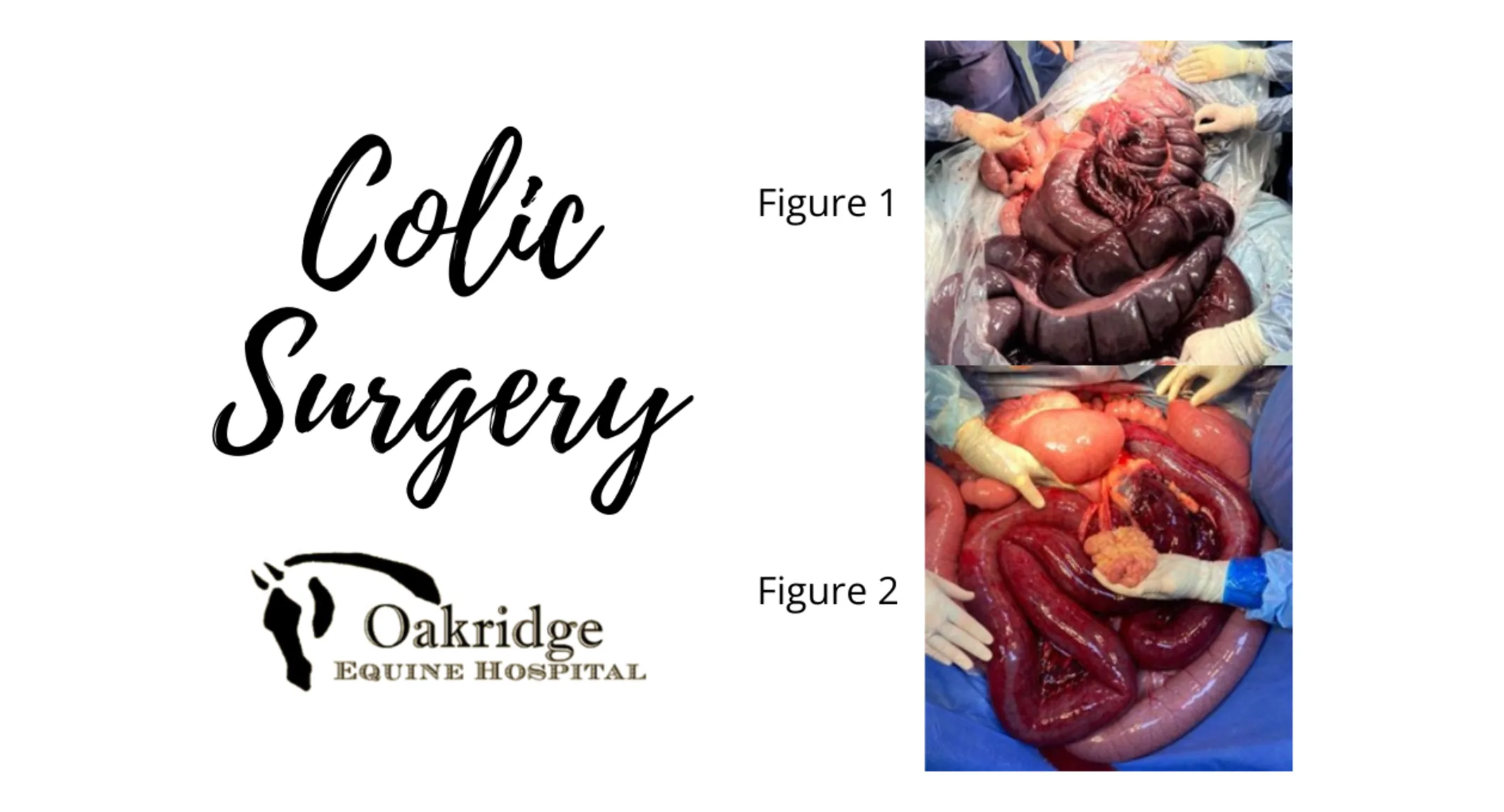Colic Surgery: How far have we come? What should you expect? What are common misconceptions?
December 18, 2024 · Equine

What are common misconceptions?
Colic can be a very serious health problem in horses and accounts for approximately 28% of deaths every year (1) Approximately 90% of colic cases can be resolved with medical management (without surgery). However, the 10% that do require surgery would likely end in death without surgical intervention (2). Therefore timely evaluation and treatment is paramount.
Exploratory celiotomy, commonly known as “colic surgery” has a relatively short history with colic surgery only becoming more common place for treatment of colic in horses in the early 1970’s (3). In the last 50 years colic surgery has undergone unprecedented advancements and the overall chance of survival in horses undergoing colic surgery have greatly improved (4).
Although it is common for me to hear, “Well Doc, I just have had some really bad experiences with colic surgery and they usually don’t make it. If they do make it, I usually can’t use them again like I had intended to.” This train of thought is no longer warranted due to the advancements we’ve made. Currently, the survival rate for horses to recover from colic surgery itself ranges from 74% to 85% and the chances that the horse will return to athleticism are also favorable with rates ranging from 63% to 85% (3).
When trying to decide what to do if your horse has a colic episode that requires surgery and to understand the chances of survival or a favorable outcome in horses that require colic surgery, I think it’s very important to consider what the surgeon believes is the problem or cause of colic in your horse. This is an a very well-educated guess on their part and you don’t know 100% for sure until you are actively performing the surgery but, your surgeon’s suspicions and assessment can help with making decisions on whether having colic surgery is something that is in the best interest of the horse and yourself.
In general, issues involving the small intestine (such as strangulating lipoma, ileal impaction or intussusception) have a higher chance of developing complications after surgery as the small intestine is generally more delicate than the large intestine. Approximately 60% (5, 6) of cases develop complications after colic surgery for a small intestinal problem compared to 40% of horses developing complications after colic surgery for a strangulating problem involving their large colon (7). When I’m presented with horses that are colicing and make it clear that they need surgical intervention; I find this distinction between small and large intestinal problems to be a very important component of the conversation that I have with owners.
Some of the most common complications that could develop following colic surgery (and could even require a second surgery are adhesions and post-operative ileus. Adhesions are essentially fibrinous tags that form between pieces of intestine or at times between intestine and the abdominal wall. These tags often cause colic signs in the horse after colic surgery as early as 5-7 days after surgery and this occurs for a variety of reasons. A recent study showed that as many as 22% of horses undergoing colic surgery for a small intestinal related problem (8). Adhesions can kink the intestine causing a mechanical blockage which leads to colic signs or sometimes they can cause pain as they pull on the intestine when feed material is making its way through. On the other hand, post-operative ileus is different in that instead of it being a mechanical problem (adhesions) instead, this is a functional problem where the intestine is not working as it should and fluid/feed material begins to get backed up into the stomach leading to what we call “gastric reflux”. The reported prevalence of post-operative ileus has a wide range with some reports as high as approximately 50% of horses with issues of the small intestine developing this complication after colic surgery (9). This can be very costly to treat as it often requires extensive supportive care and can significantly affect the chances of your horse surviving after having a colic surgery.
Having described those serious complications, I do think it’s worth noting that there have been significant improvements over the years with how we manage these conditions and our rates of success. A horse with a small intestinal cause of colic typically has a less favorable chance of survival but, this does not mean that it is instantly a death sentence. I think as a horse owner it is important to understand that if there is a type of colic surgery that would have issues afterwards, this would be the one. Therefore, as a horse owner if you choose to pursue treatment of a small intestinal colic problem with surgery you must take all of this in to account and have realistic expectations about possible outcomes for your horse.
Colic surgery for conditions affecting the large colon or small colon tend to have much higher rate of success with the prognosis for surgical correction of a right dorsal displacement and nephrosplenic entrapment being >90%, large colon volvulus being 70-80% and small colon obstructions >90% (10). In general, conditions affecting the large colon or small colon usually have less post-operative complications as long as there has not been significant loss of blood supply to a portion of the intestine during the colic insult for example as seen with severe large colon volvulus (Figure 1). Horses that undergo colic surgery for large intestinal problems usually have a shorter hospital stay, fewer complications after surgery and are typically able to eat normal amounts of food pretty quickly after the colic surgery.
A common misconception associated with colic surgery is that older horses are less likely to do well after surgery or unable to handle the recovery associated with colic surgery. As some say “age is not a disease” and this holds true with horses. The fact that increased age does not increase the chances of complications after colic surgery or inability to recover successfully has been proven with multiple studies to be false (4). However, a recent study did find that horses that were greater than 20 years of age did have a 17 times greater risk of developing an infection at their incision (11). With increased age (>15 years old) there is an increase in fat deposition in some horses within their abdomen and around the intestines. This increase in fat deposition leads to an increased risk for developing fatty lipomas that can eventually get large enough to wrap around the small intestine and cause them to lose blood supply leading to colic signs and the need for colic surgery to correct the problem (Figure 2).
Another common misconception is the amount of time that a horse must be on rest after a colic surgery and this can vary from surgeon to surgeon. However, the following protocol is one that I use and have seen used in multiple other institutions that I have worked at over the years. Typically, the first month after colic surgery (30 days) the horse is placed on strict stall rest with small amounts of daily hand walking or hand grazing. In the second month the horse can be placed in a small turnout (size of a round pen) with no other horses with continued hand walking/grazing. On the third month after colic surgery, barring no incisional complications, the horse can be turned out into pasture for one month. After this they can slowly over the timespan of 1-2 months be brought back into forced exercise and work. It is safe to say that after a horse has colic surgery you should plan for them to be on a period of rest, with no work for a minimum of three months which can have a significant impact on horses show schedules, upcoming races, etc. All of these exercise restrictions and inherent rehabilitation time after surgery should be taken into mind by the owner when making the decision to have colic surgery.
Colic surgery is often scary and daunting as a horse owner. However, the advancements that have been made and are still being made; make colic surgery one that should not be viewed as a death sentence but more as a viable treatment option. It is important to remember that age does not affect a horse’s ability to recover from colic surgery and should not be viewed as a reason to not pursue this life-saving treatment. However, the cause of colic or region of intestine that is affected can have a profound effect on the overall chances of survival and most importantly ability to return to work. As a horse owner it is important to keep this in mind and have realistic expectations when making the decision to take your horse to colic surgery; especially when there is involvement of a section of intestine that has a less favorable outcome. Having a plan in place for what you are able to do for your horse in the event of a colic episode, having means of transporting your horse to a hospital and assigning a contact person in case you’re out of town is essential as a horse owner; as with these matters typically time is of the essence.
Author:
Gabriel A. Gonzalez, DVM, MS
Associate Oakridge Equine Hospital
Short Bio:
Dr. Gonzalez is originally from Kissimmee, FL and graduated veterinary school in 2020 from North Carolina State University. He successfully completed a surgical residency at Mississippi State University in 2024 and is now primarily working in equine surgery and emergency medicine at Oakridge Equine Hospital. His professional interests include arthroscopic surgery, upper airway surgery, lameness, colic surgery, sinus surgeries, and advanced imaging (computed tomography or CT).
References:
1. Tinker MK, White NA, Lessard P, et al. Prospective study of equine colic incidence and mortality. Equine Vet J. 1997;29(6):448-453. doi:10.1111/j.2042-3306.1997.tb03157.x
2. Spadari A, Gialletti R, Gandini M, et al. Short-Term Survival and Postoperative Complications Rates in Horses Undergoing Colic Surgery: A Multicentre Study. Animals (Basel). 2023;13(6). doi:10.3390/ani13061107
3. Salem SE, Proudman CJ, Archer DC. Prevention of post operative complications following surgical treatment of equine colic: Current evidence. Equine Vet J. 2016;48(2):143-151. doi:10.1111/evj.12517
4. Freeman DE. Fifty years of colic surgery. Equine Vet J. 2018;50(4):423-435. doi:10.1111/evj.12817
5. Morton AJ, Blikslager AT. Surgical and postoperative factors influencing short-term survival of horses following small intestinal resection: 92 cases (1994-2001). Equine Vet J. 2002;34(5):450-454. doi:10.2746/042516402776117700
6. Semevolos SA, Ducharme NG, Hackett RP. Clinical assessment and outcome of three techniques for jejunal resection and anastomosis in horses: 59 cases (1989-2000). J Am Vet Med Assoc. 2002;220(2):215-218. doi:10.2460/javma.2002.220.215
7. Driscoll N, Baia P, Fischer AT, Brauer T, Klohnen A. Large colon resection and anastomosis in horses: 52 cases (1996-2006). Equine Vet J. 2008;40(4):342-347. doi:10.2746/042516408X293529
8. Baxter GM, Broome TE, Moore JN. Abdominal adhesions after small intestinal surgery in the horse. Vet Surg. 1989;18(6):409-414. doi:10.1111/j.1532-950x.1990.tb01115.x
9. Cohen ND, Lester GD, Sanchez LC, Merritt AM, Roussel AJ. Evaluation of risk factors associated with development of postoperative ileus in horses. J Am Vet Med Assoc. 2004;225(7):1070-1078. doi:10.2460/javma.2004.225.1070
10. Auer J, Stick J. Equine Surgery. 5th ed. (Kummerle J, Prange T, eds.). Elsevier; 2019.
11. Scharner D, Winter K, Brehm W, Kämpfert M, Gittel C. Incisional complications following ventral median coeliotomy in horses. Does suturing of the peritoneum reduce the risk? Tierarztl Prax Ausg G Grosstiere Nutztiere. 2017;45(1):24-32. doi:10.15653/TPG-160536
